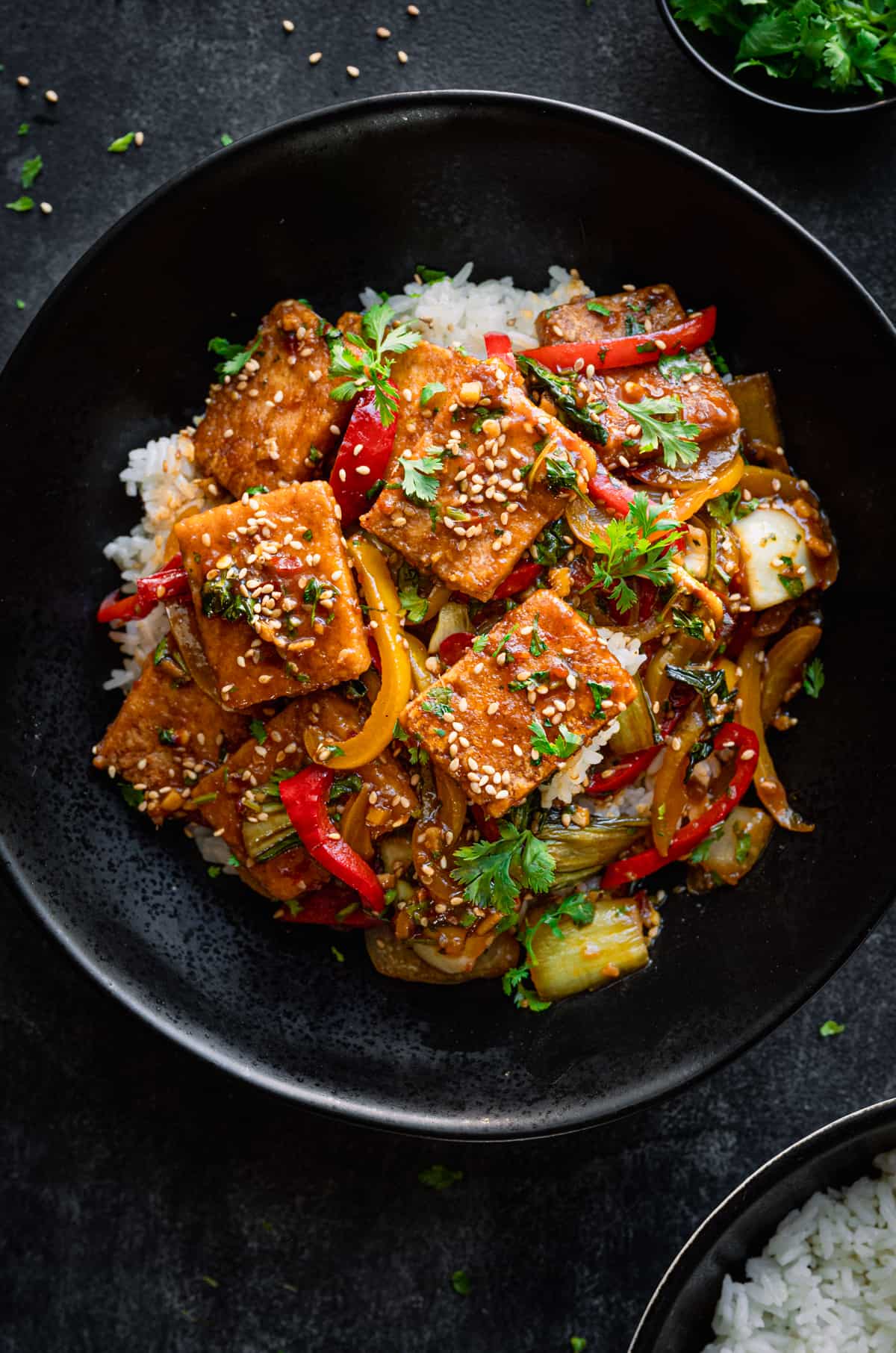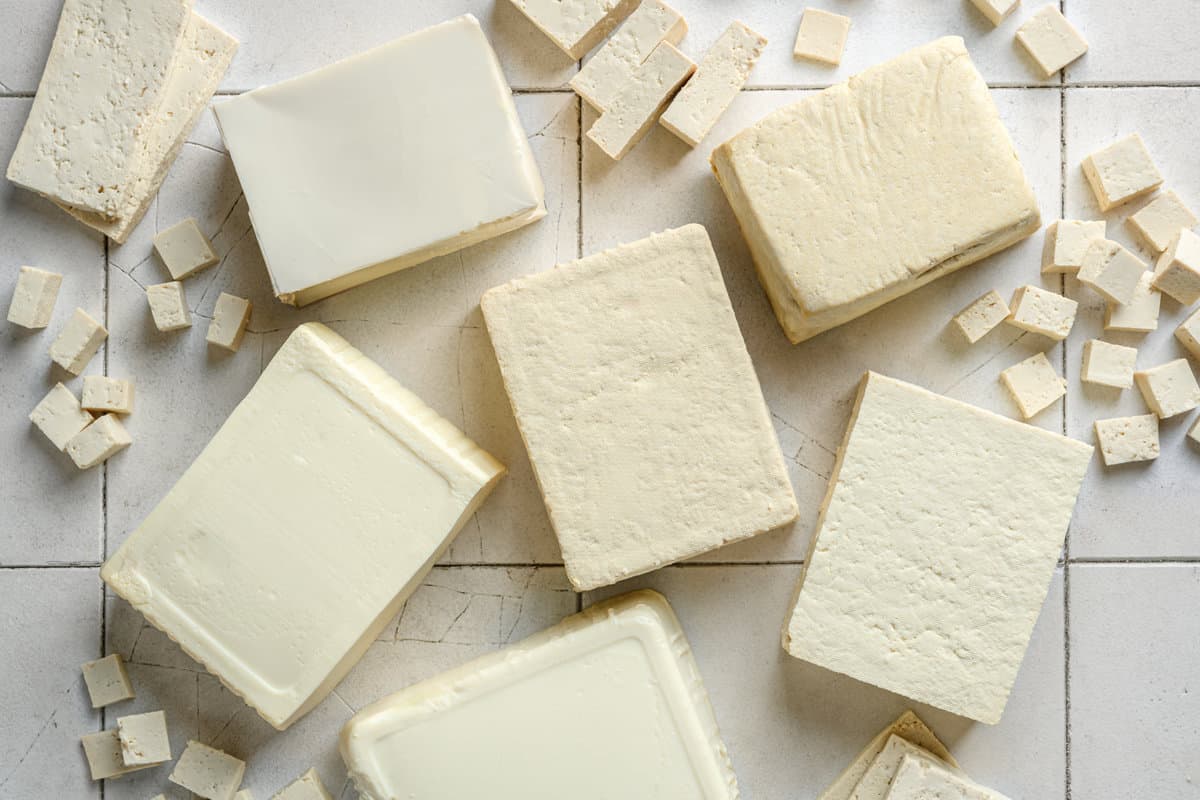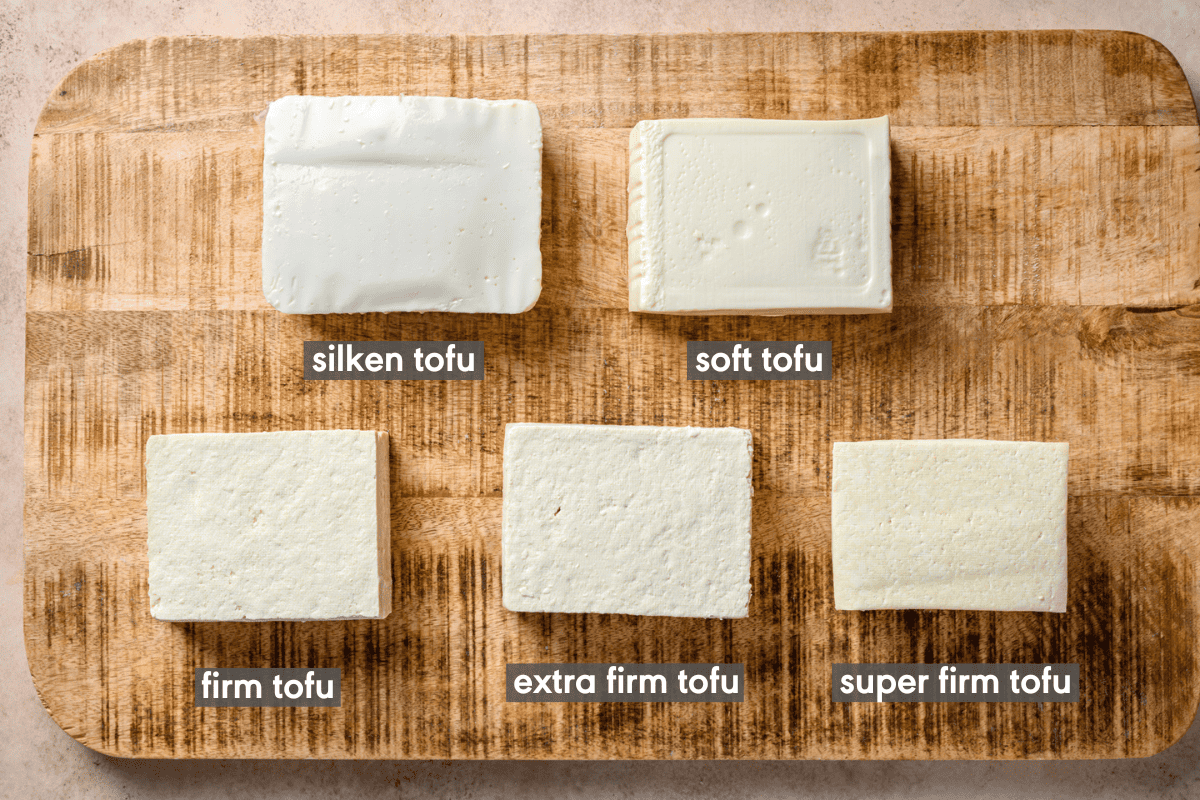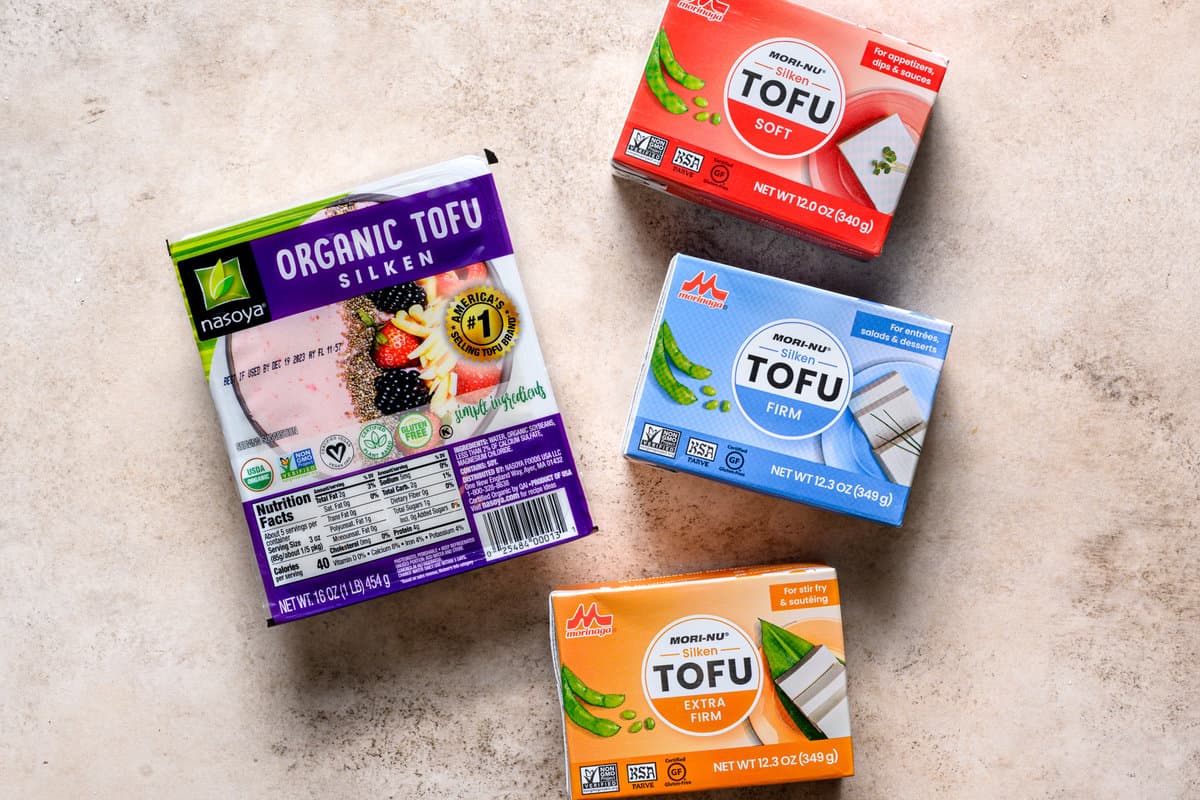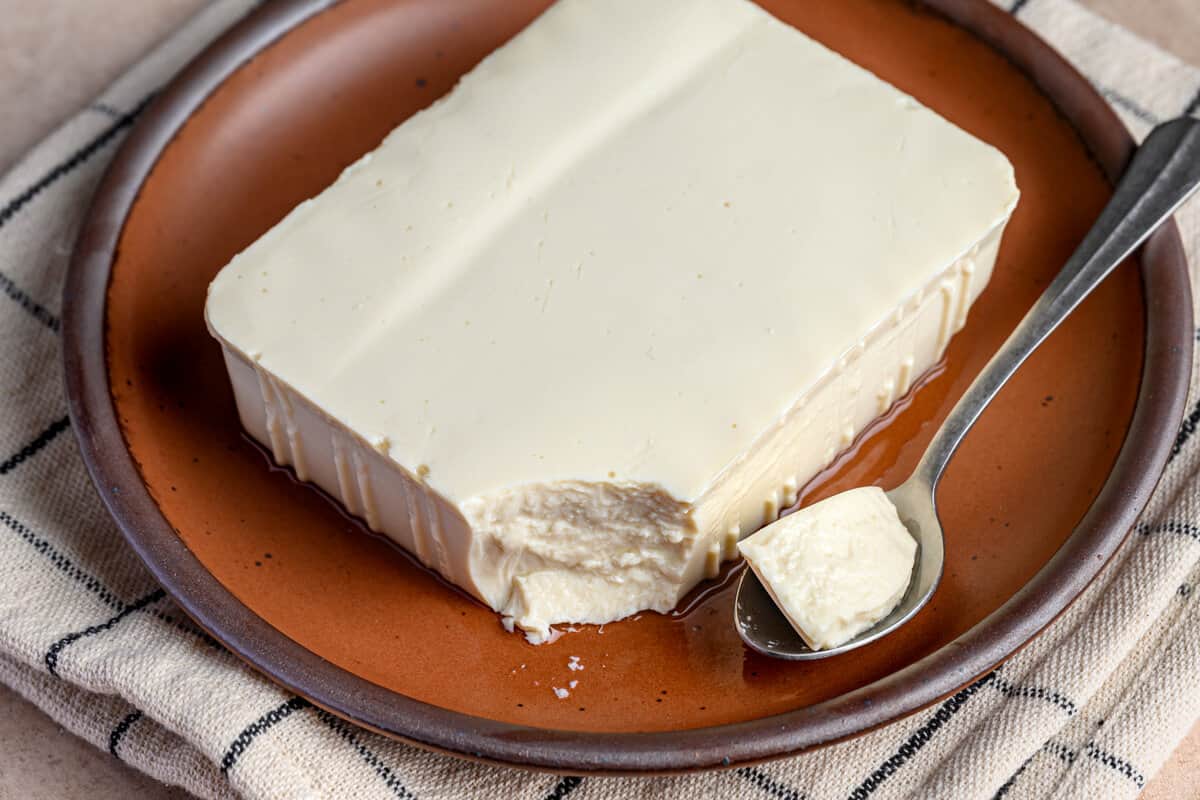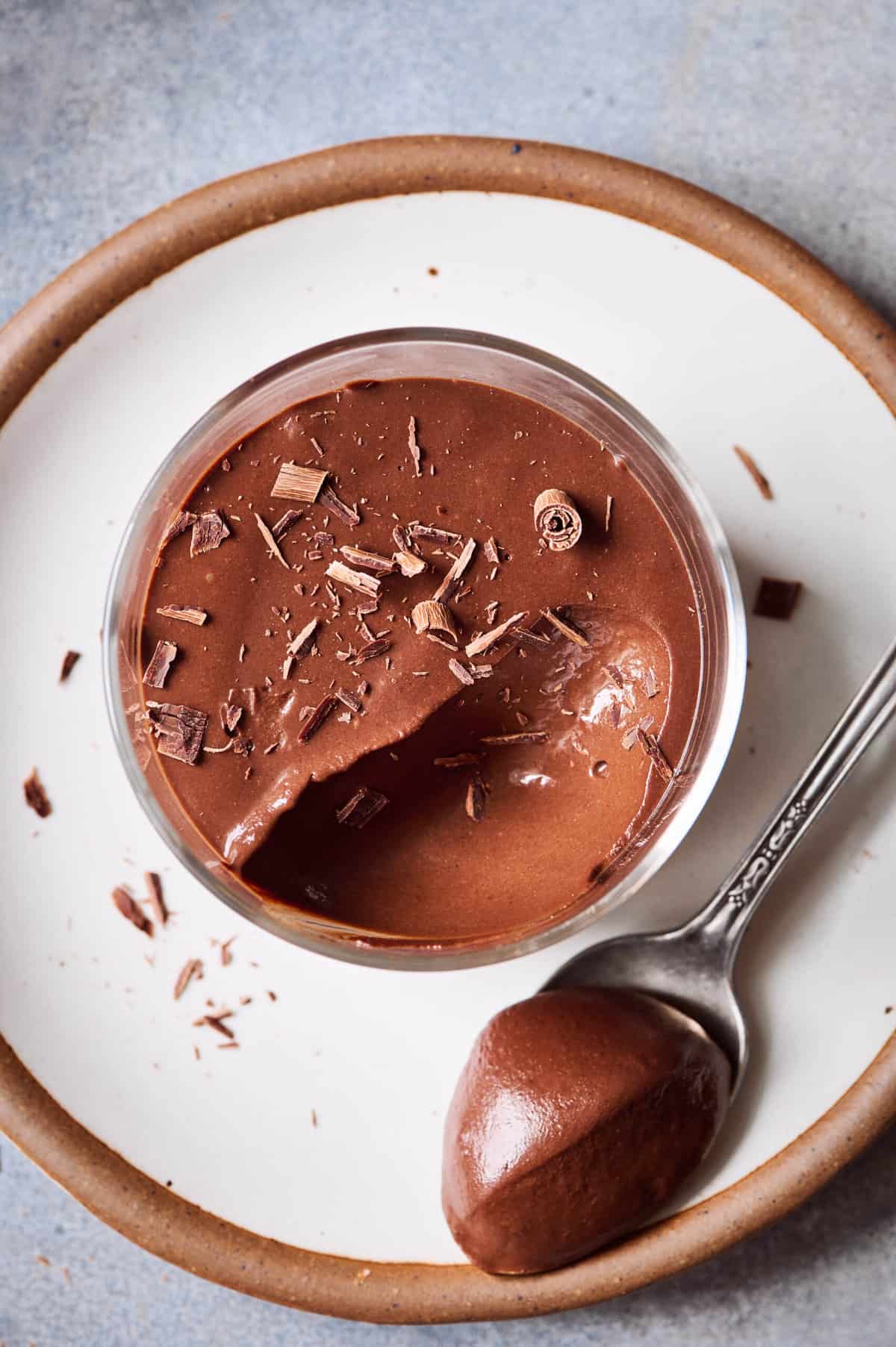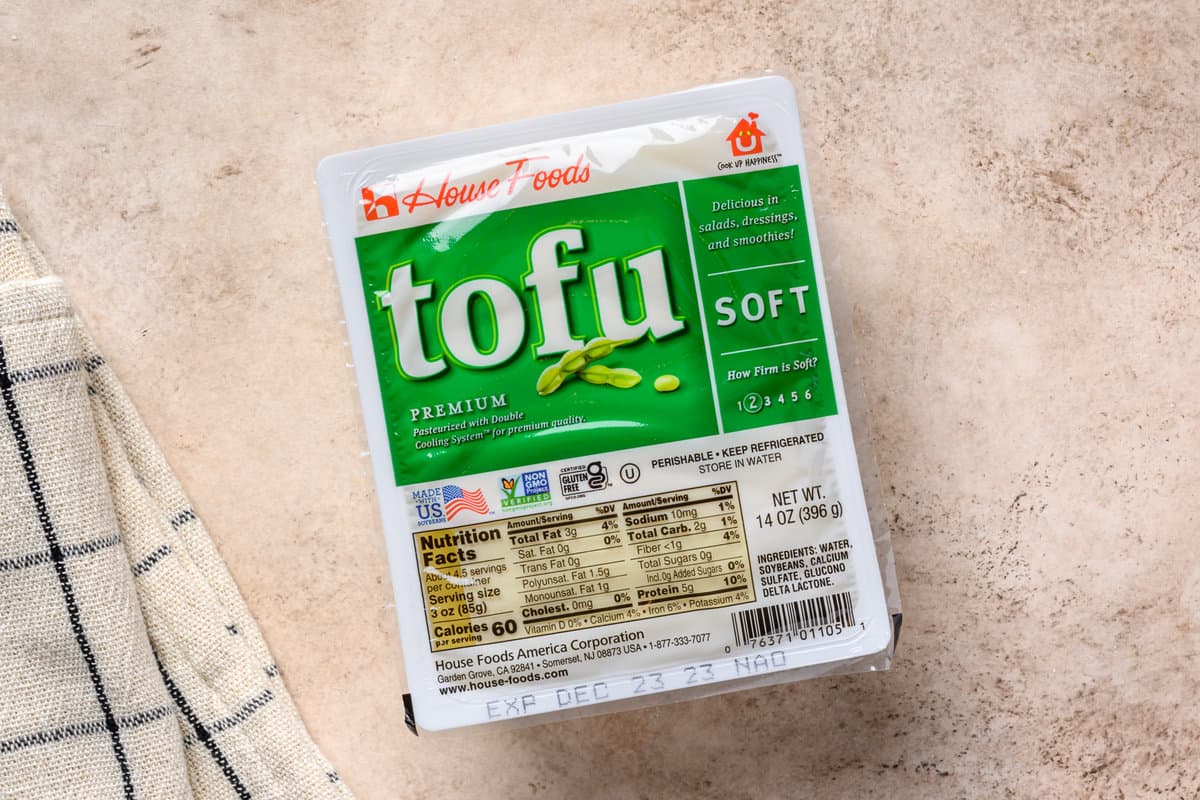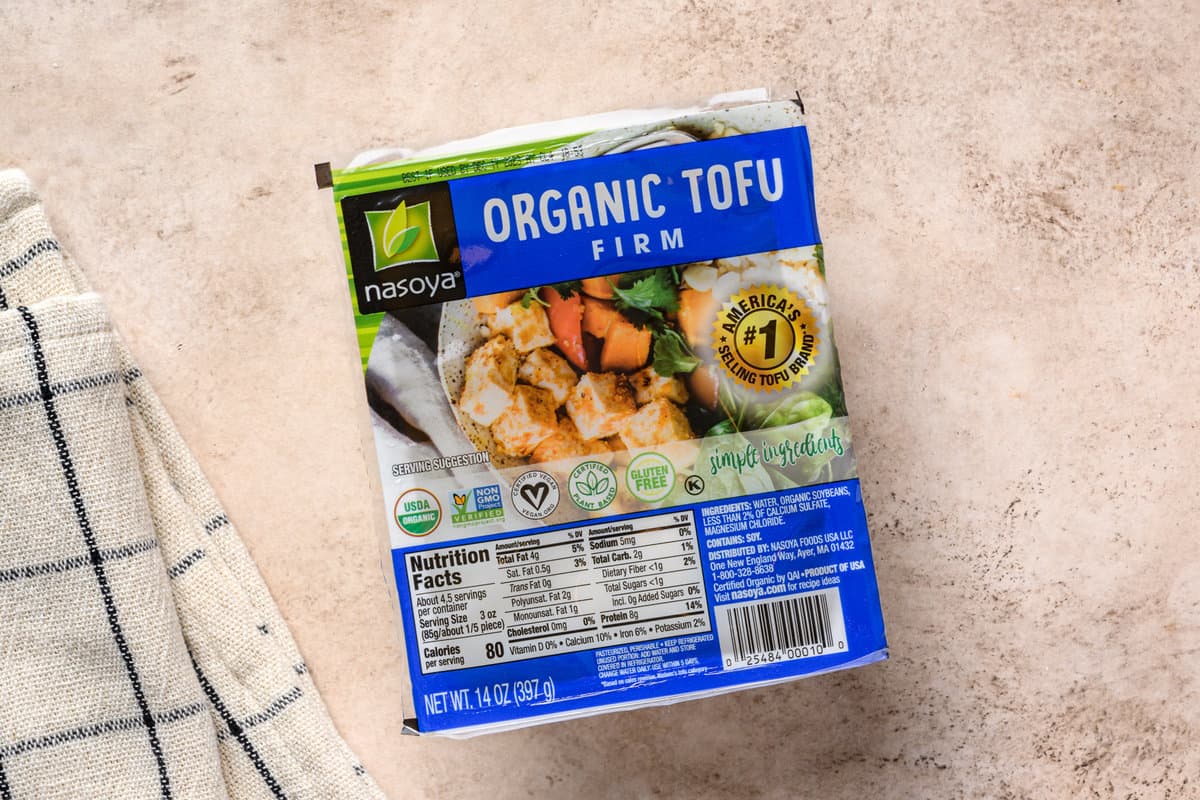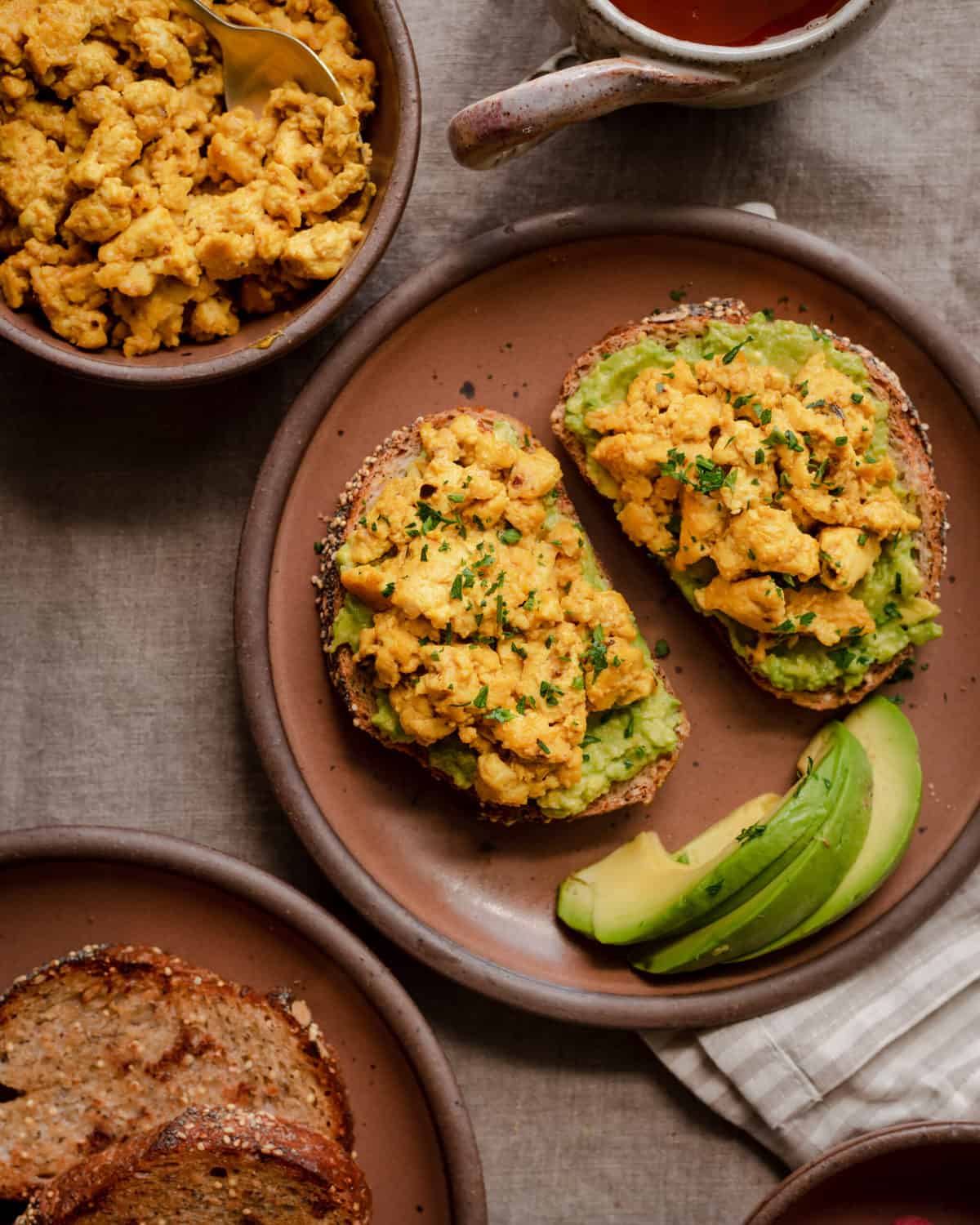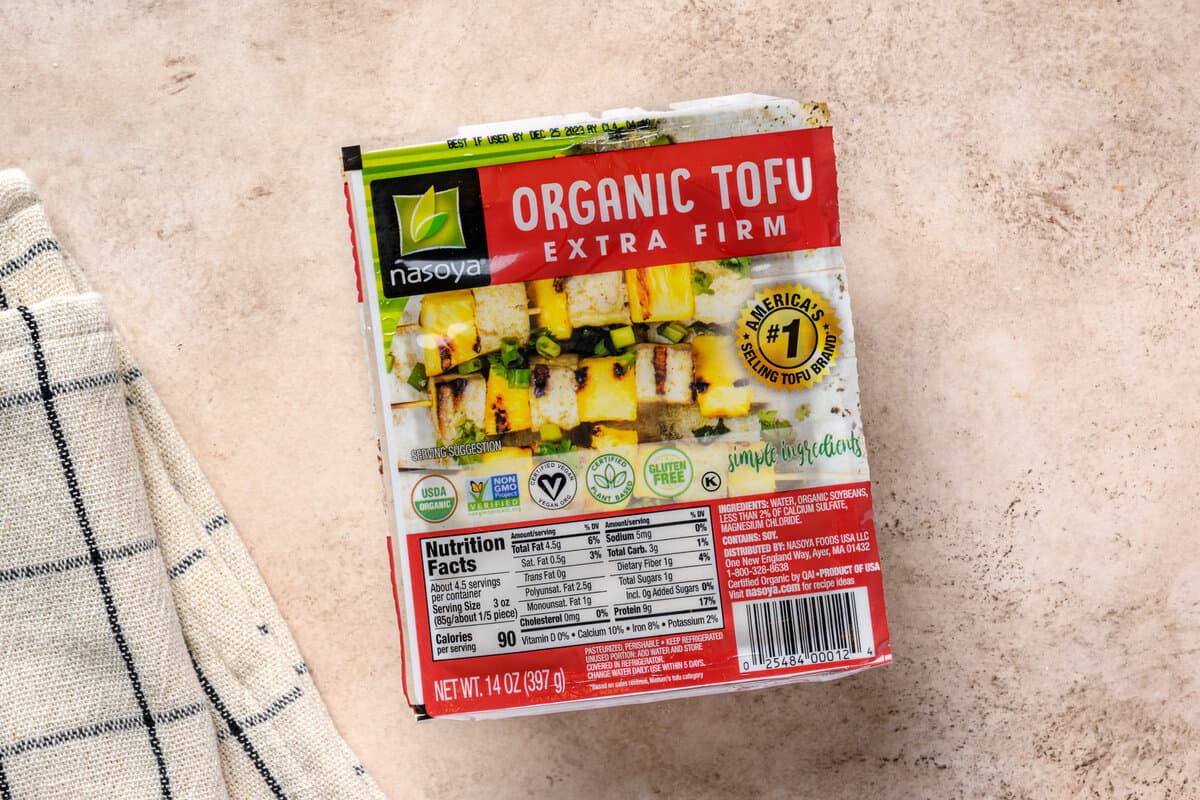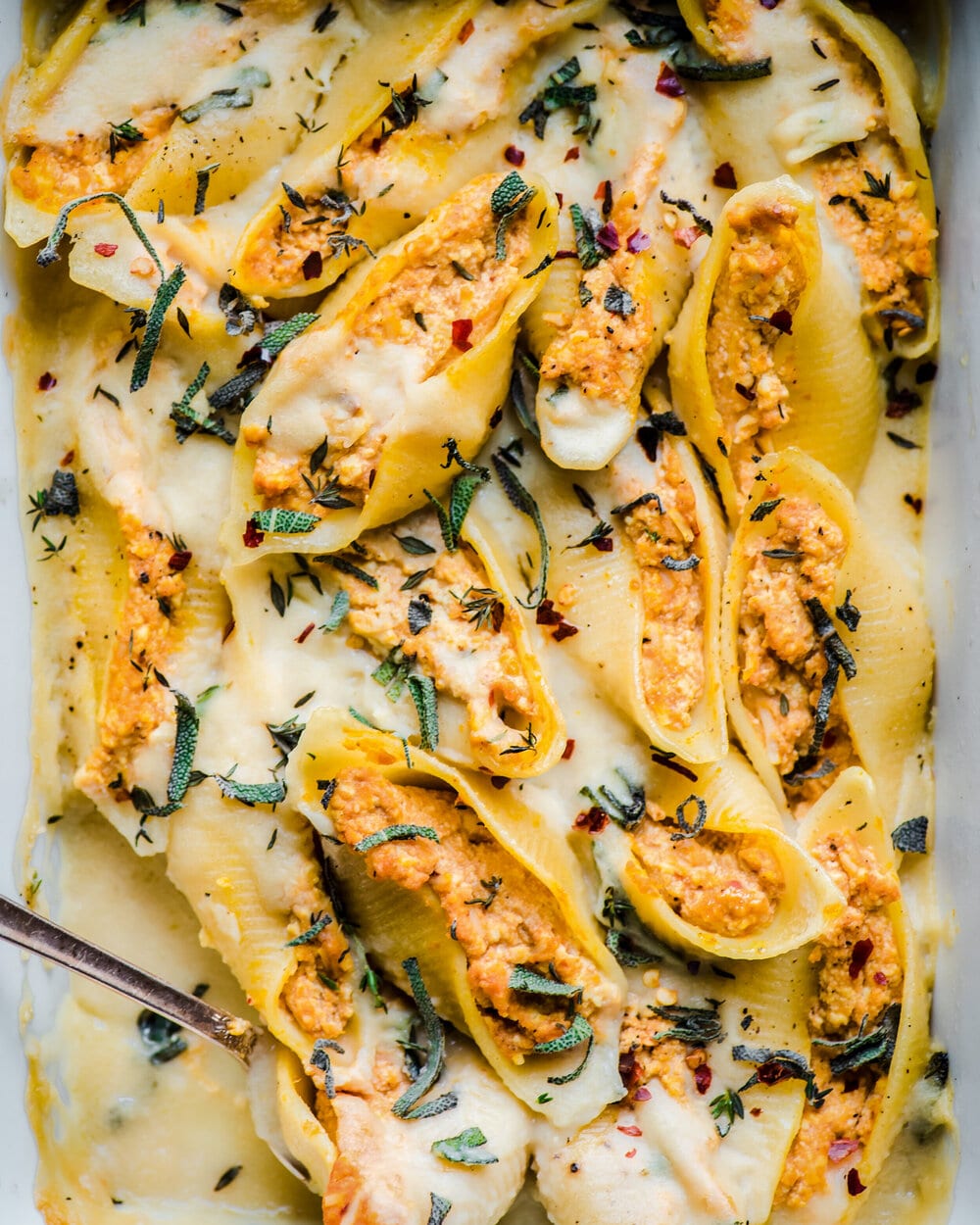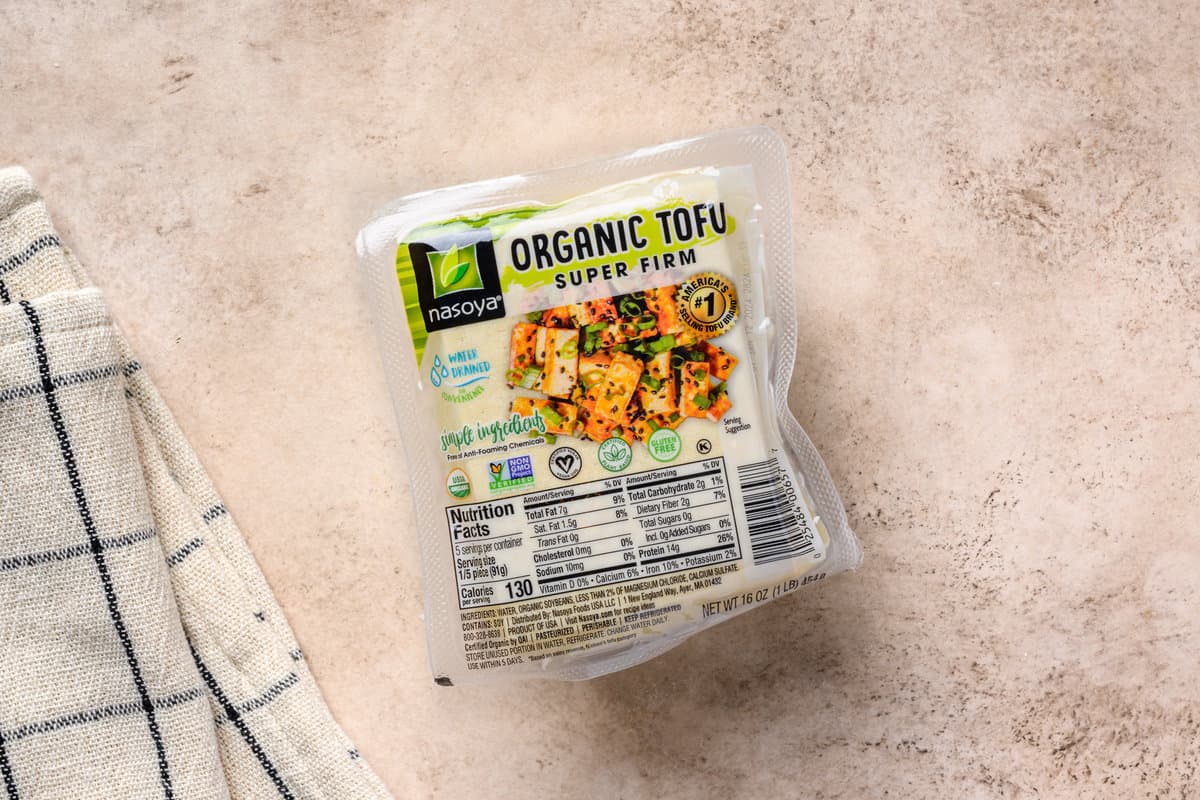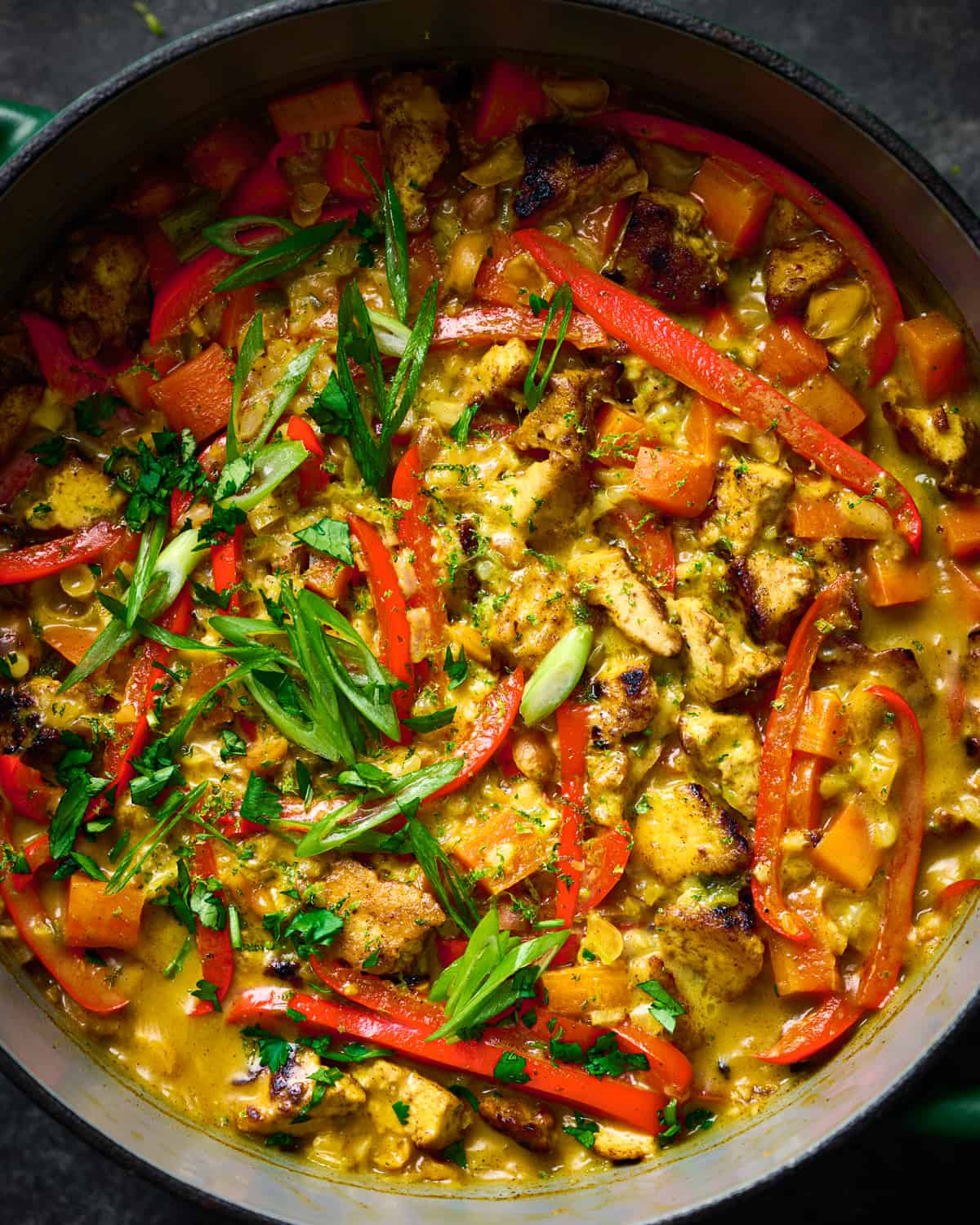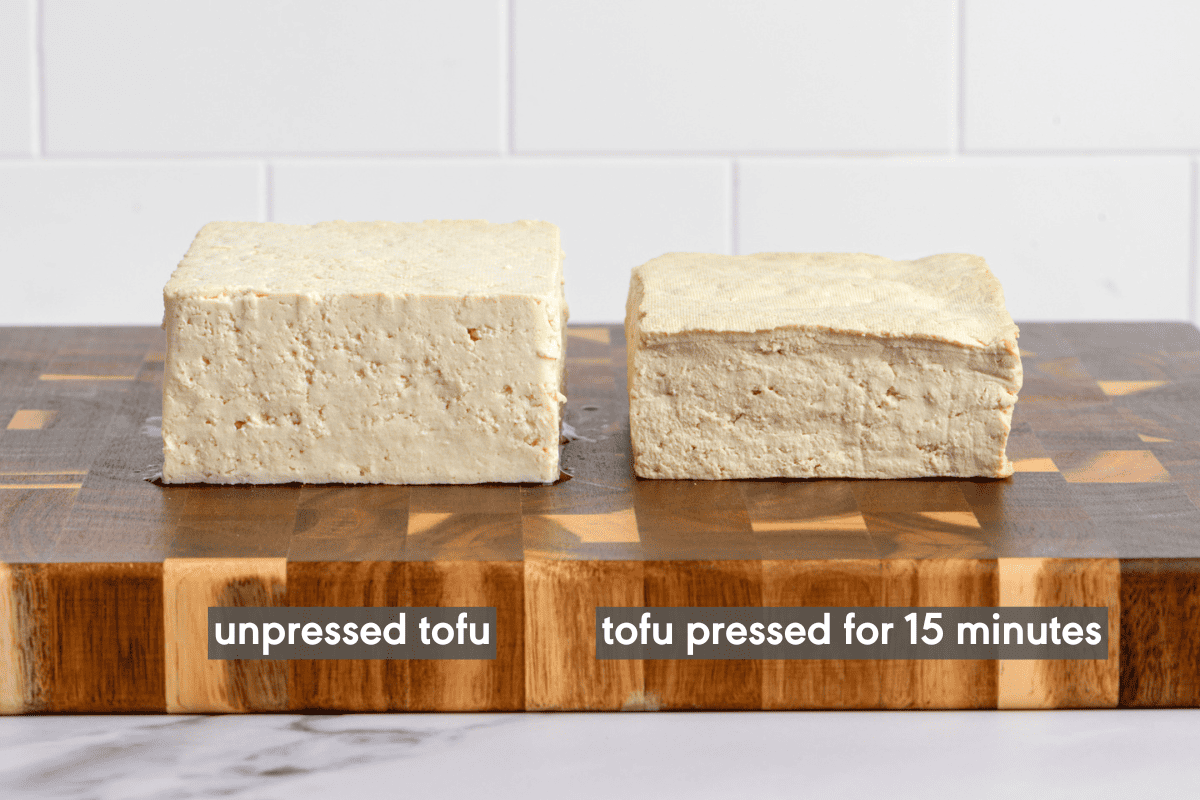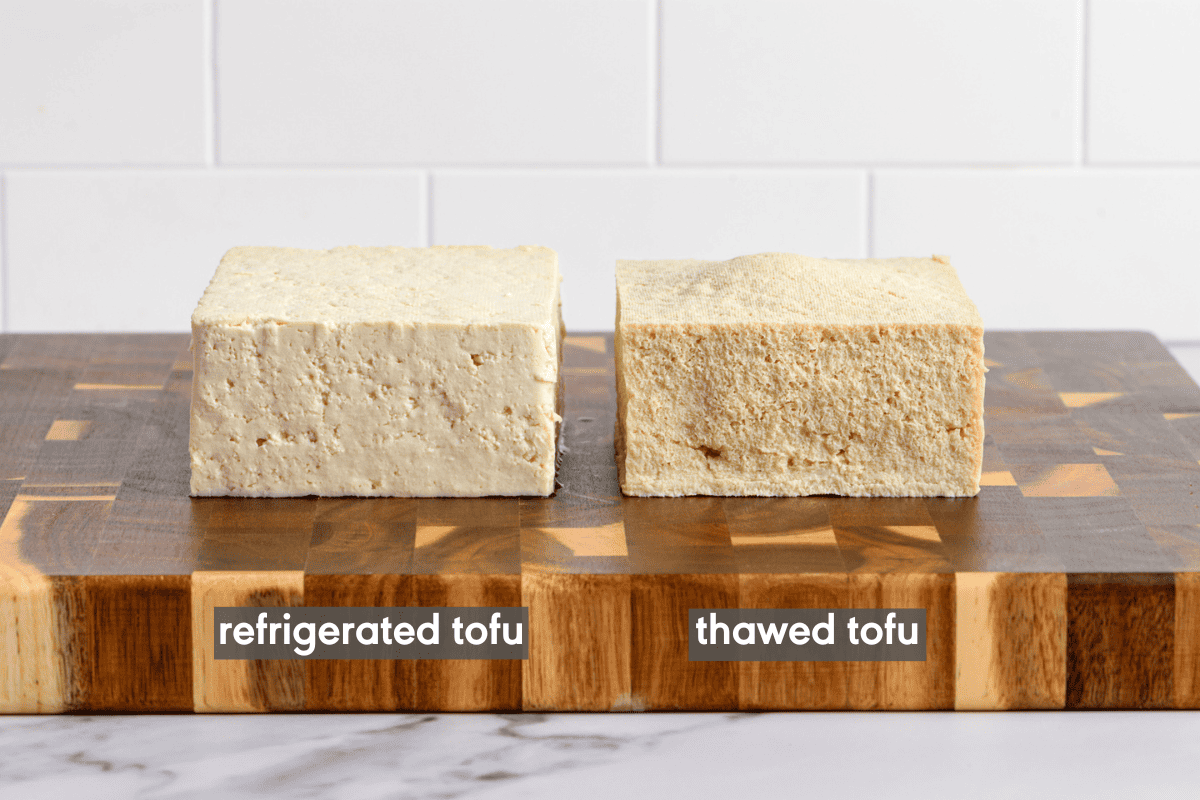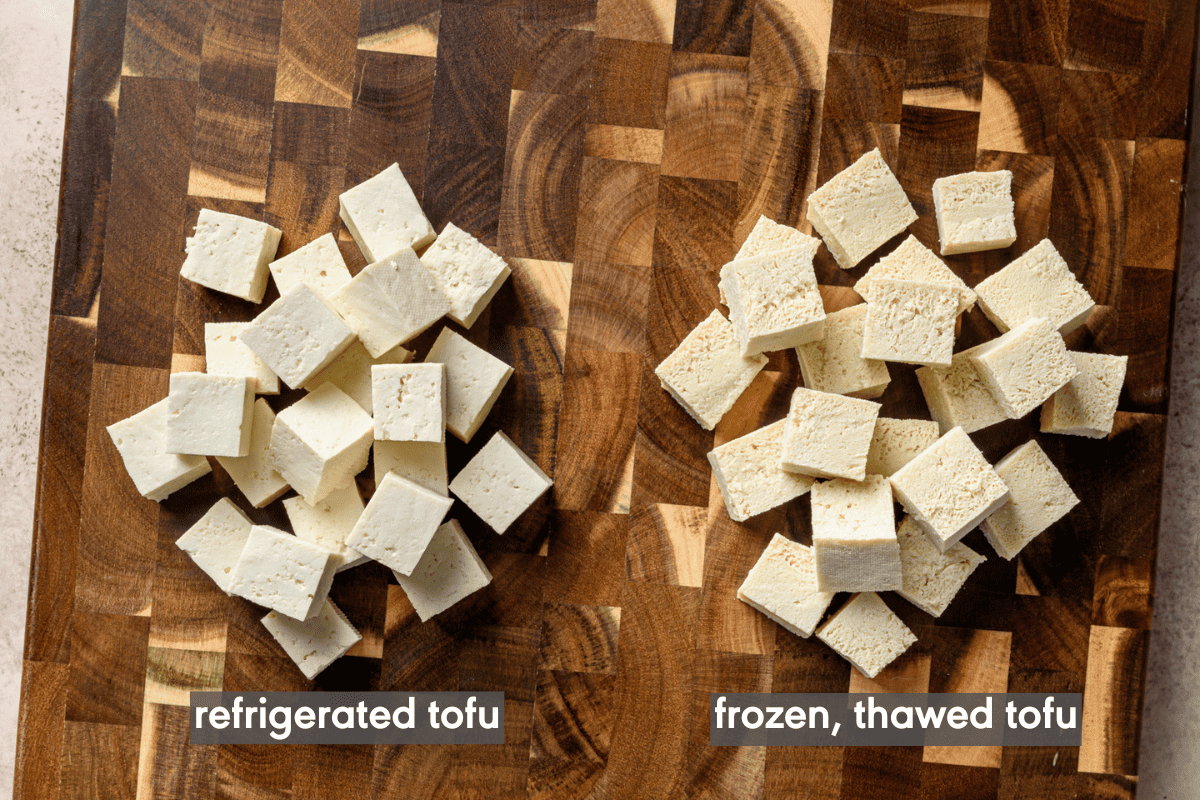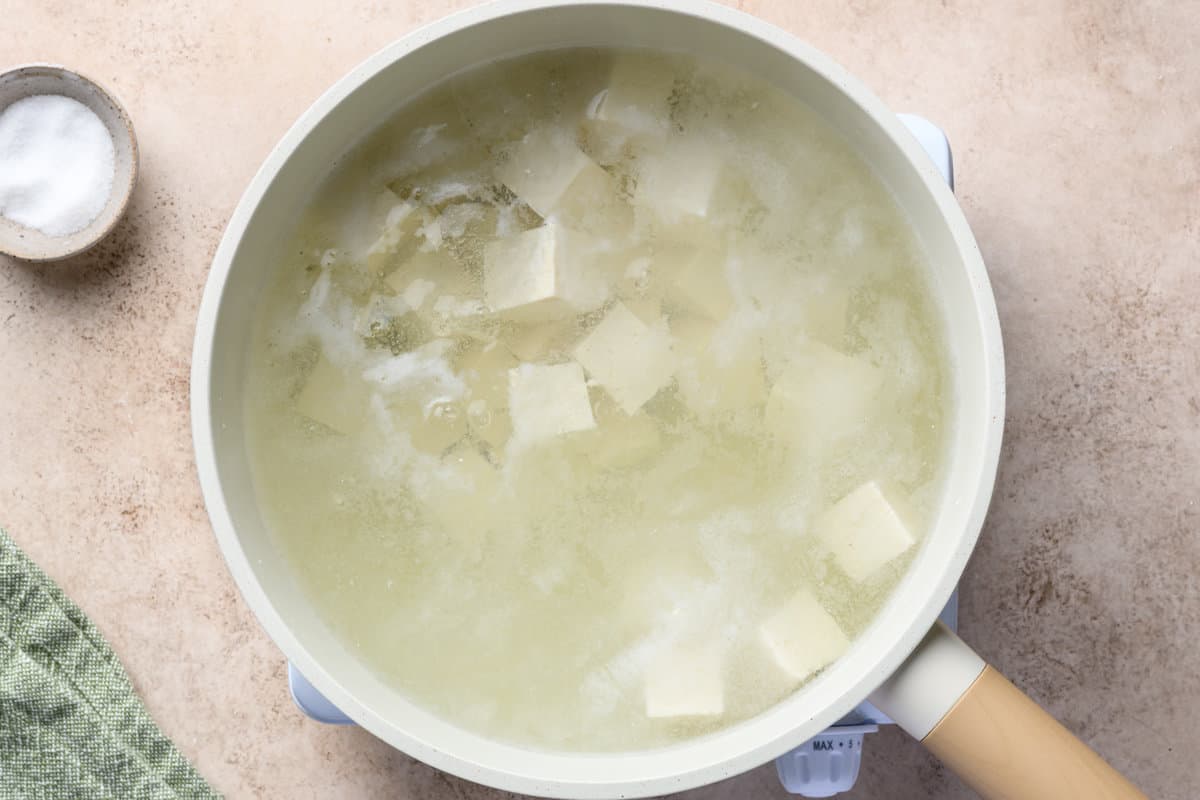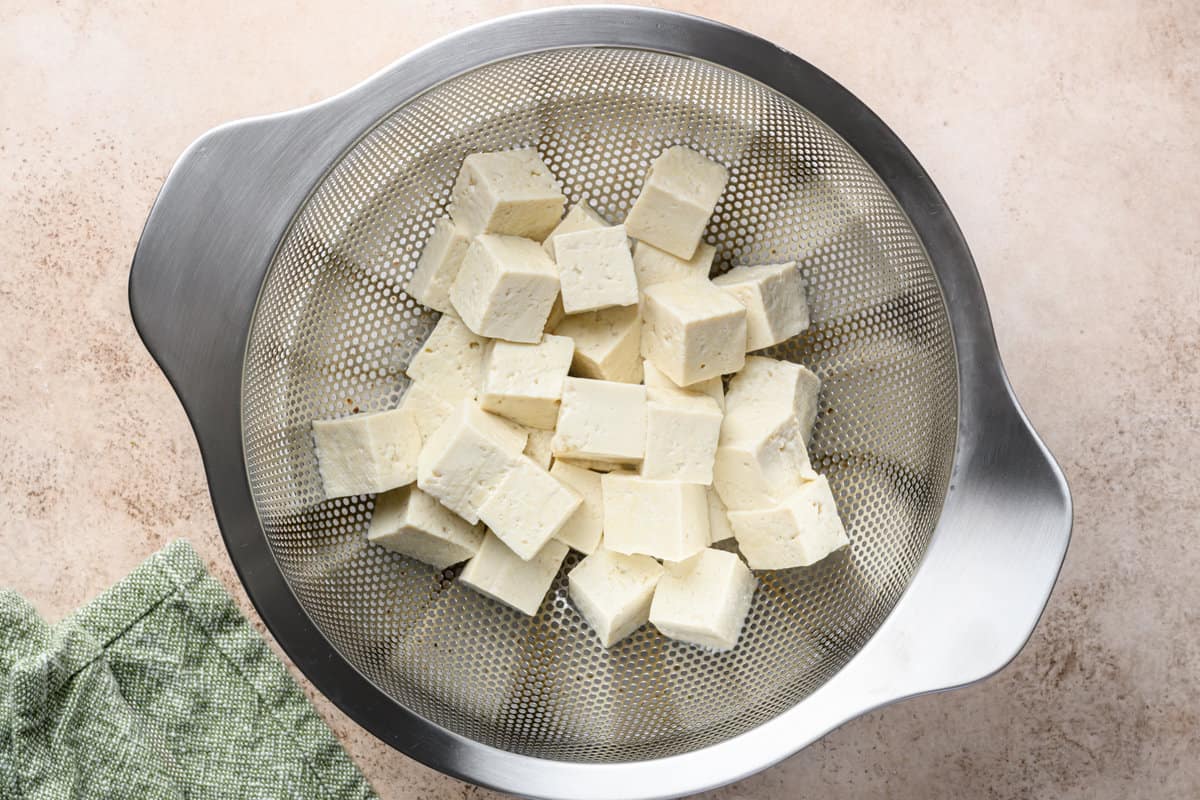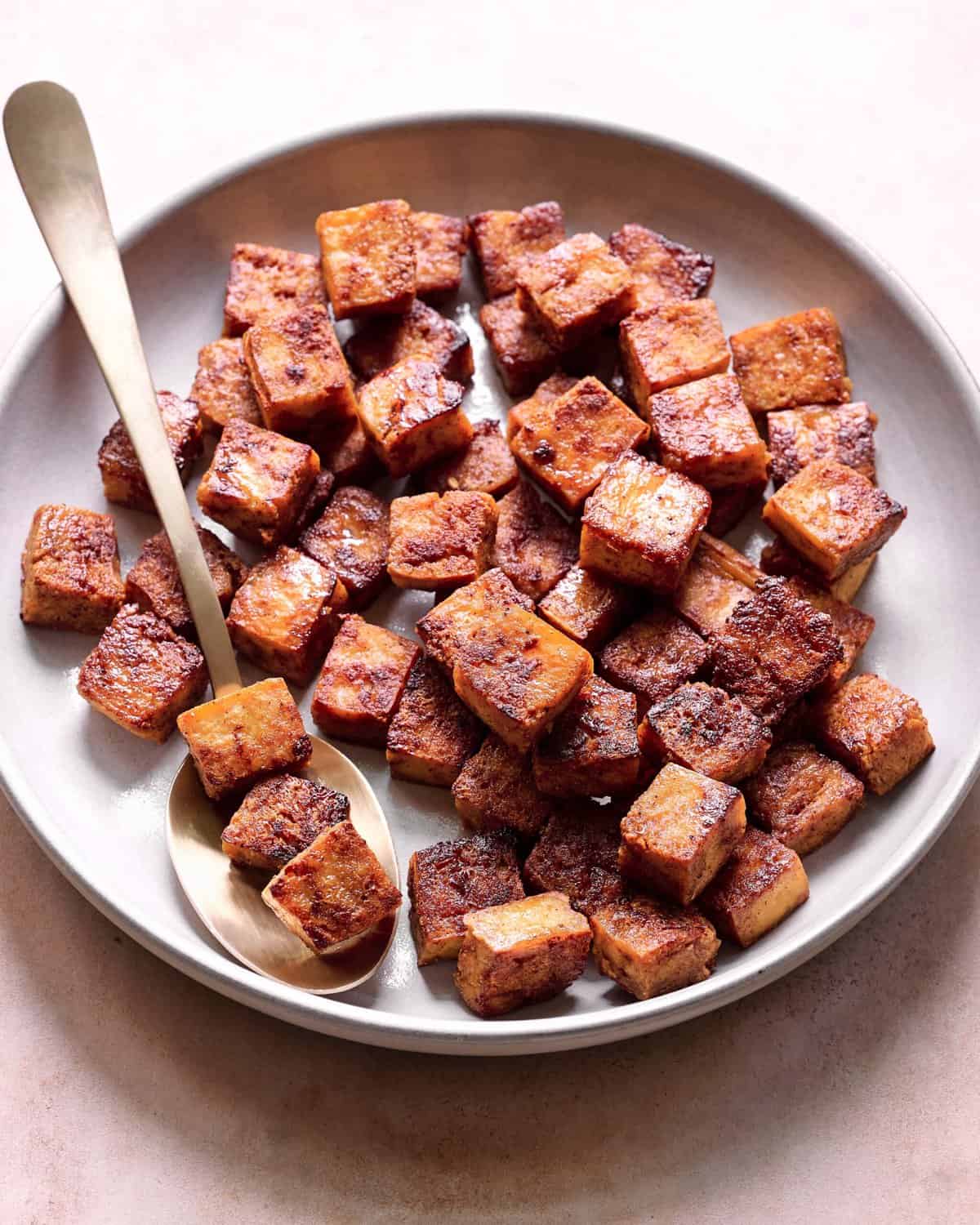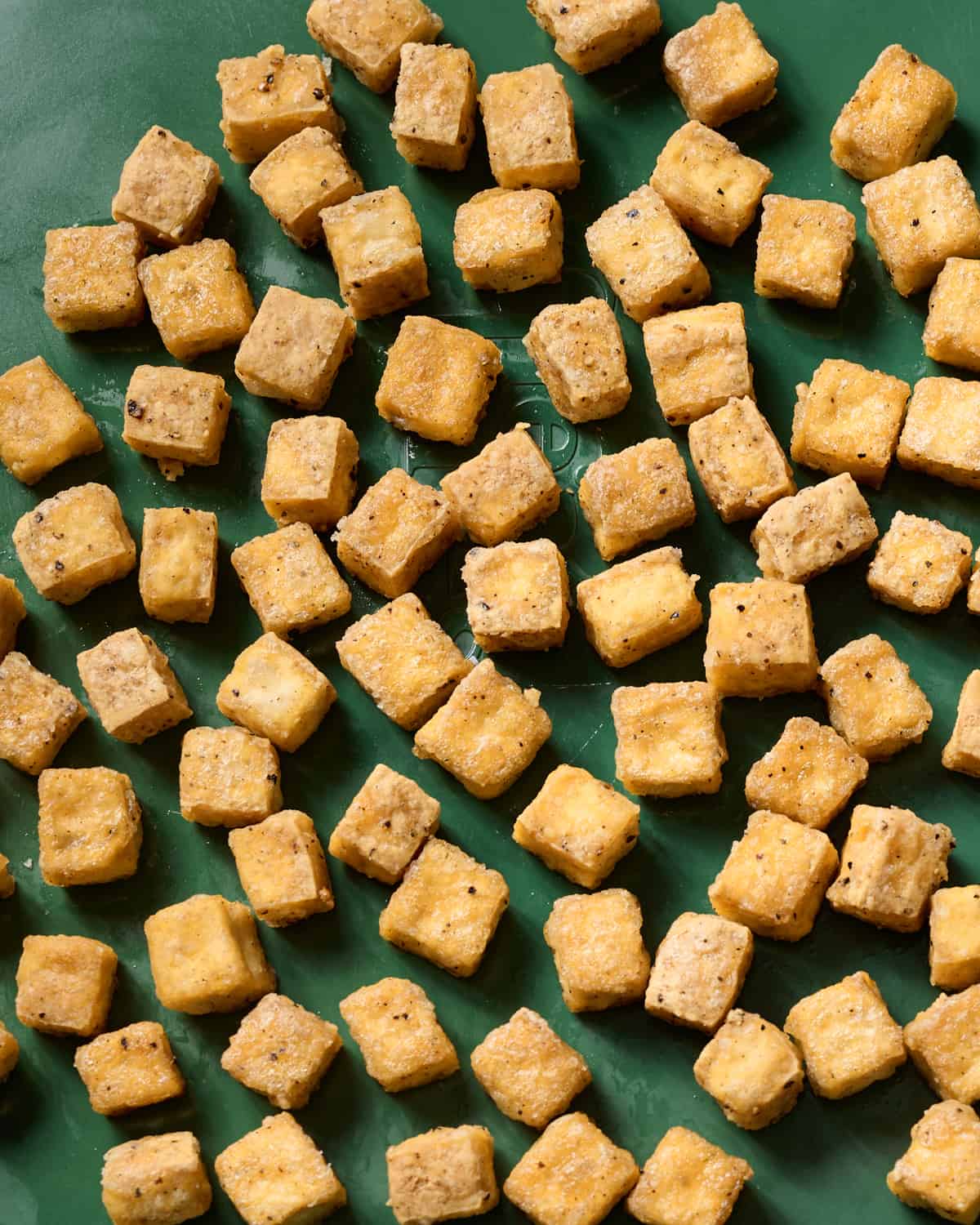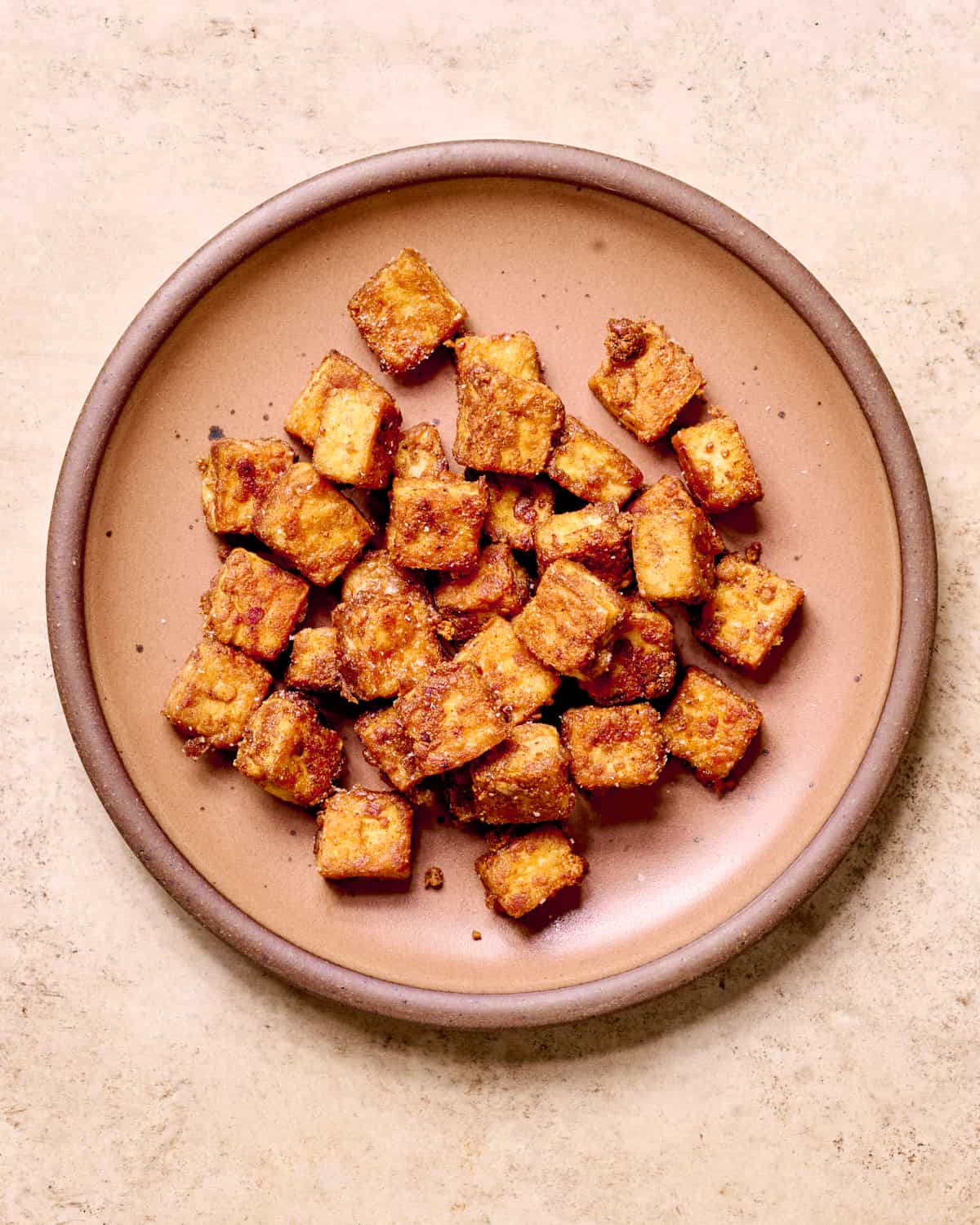This thorough guide teaches you all you need to know about how to cook tofu, four methods for enhancing its flavor, as well as plenty of beginner-friendly recipes to help get you started. By the end, you’ll not only know how to cook tofu but how to bring out the best of this versatile ingredient! Already know everything there is to know about tofu and just looking for recipes? Choose from 40 terrific tofu recipes here! Or want to learn more about tempeh? Read my guide on cooking tempeh here! Table of contents:1. What is tofu?2. Is tofu healthy?3. Different types of tofu4. How to make tofu more flavorful5. How to cook tofu
What is tofu?
Tofu is a soy product made from soybeans and water (AKA soy milk). The two are cooked together with a coagulant (usually nigari or gypsum) to help curdle the mixture. Those curds are then pressed into a solid block and left to cool. Now, serving tofu raw isn’t always the best way to experience this plant-based protein because its flavor is very bland. But because of its texture, tofu is excellent at absorbing the flavors of other seasonings, sauces, and marinades.
Is tofu healthy?
Don’t listen to the fear-mongering about soy products! It’s been proven again and again that minimally processed soy-based foods like tofu are not bad for you. In fact, tofu comes with heaps of health benefits. A 3-ounce serving of extra firm tofu has 70 calories, 8 grams of protein, 2 grams of fiber, 10% of daily calcium needs, 8% of daily iron needs, and 0g of saturated fat. Also, a range of esteemed medical studies have repeatedly shown that moderate consumption of natural soy products like tofu (or tempeh, edamame, or soy milk) is associated with good heart health and linked with reduced risk for certain cancers, particularly breast and prostate cancer. PS: “Moderate” consumption is considered up to twice a day, which is even more than I, a tofu-loving vegan, eat most days. New to vegan cooking? Check out The Ultimate Vegan Grocery Shopping List to answer all your grocery shopping-related questions, then hop on over to The 5 Best Vegan Protein Sources to learn how to incorporate plant protein into your diet.
Different types of tofu
Not all tofu is made equally! Some are watery and soft while others are more coarse and porous, making them easier to shape into blocks. There are two main varieties of tofu: silken tofu and regular tofu or block tofu.
Silken tofu
Silken tofu is a “fresh” (uncooked) and very soft Japanese-style tofu. As the name suggests, it’s silky to the touch and very delicate. It contains so much liquid that if you were to pick it up, it would fall apart.
Variations
There are two variations of silken tofu: Refrigerated vs. aseptic (shelf-stable). I typically prefer refrigerated silken tofu taste-wise, but either variety works fine in recipes that call for silken tofu. You can find the refrigerated silken tofu alongside other blocks of tofu (e.g., firm tofu) at most grocery stores. There are a few varieties of aseptic silken tofu (e.g., silken soft, silken firm). Aseptic silken tofu has a longer shelf-life, which means you’ll usually find them in the pantry aisle with other Asian products in most major grocery stores. The most common brand you’ll see is Mori-nu/Morinaga.
How to cook it
Cooking silken tofu is a little difficult because it crumbles so easily. Instead, its soft and watery nature makes it a fantastic choice for serving raw or blending and pureeing. It doesn’t add any flavor when it’s used in vegan chocolate mousse, creamy dips, salad dressings, or French Toast batters. Instead, it lends a creamy, melt-in-your-mouth consistency without having to use heavy cream alternatives. Want to bulk up your breakfast and add more protein without messing with the flavor? Blend silken tofu into your favorite smoothie recipe! If you’re looking for a savory way to serve silken tofu, try serving an entire block of cold silken tofu with a deeply savory sauce and chili crisp (this recipe from the The Food Takes Flight looks amazing!). In Chinese and Korean cuisine, silken tofu is often fried, then braised with stir fry vegetables in a Shaoxing wine-based sauce, like in this recipe by The Woks of Life. This vegan hot plate recipe from Woon Heng is similar but is cooked in a richer sauce made with liquid vegan eggs.
Tips for success
Always handle silken tofu with care. It’s the most delicate type of tofu and will crumble very easily! Do not press silken tofu. Instead, simply drain the excess water from the packaging. Use it as a vegan egg substitute in recipes that rely on eggs for moisture (but not as a leavening agent) The tofu will provide moisture and binding to the baked goods. Use ¼ cup silken tofu for every 1 egg and add ⅛ to ¼ teaspoon of baking soda to help the baked goods rise.
Soft tofu
This is the first of the “regular” block-style tofu varieties. It’s almost as soft and delicate as silken tofu but is firm enough to hold its shape when being handled.
How to cook it
Soft tofu can often be used interchangeably with silken tofu. So if you can’t find silken tofu, you can blend soft tofu to make vegan mousse, pudding, salad dressings, homemade mayo, and creamy dips. An easy way to enjoy soft tofu is raw in a cold tofu salad. Instead of layering soft tofu cubes over leafy greens, they’re placed in a bowl with a soy-based sauce and topped with aromatics, like green onion, sesame seeds, and Thai peppers. If you like your scrambled eggs on the soft side, try swapping the firm tofu in my Tofu Scramble for soft tofu.
Firm tofu
Perhaps the most popular and widely available type of tofu, firm tofu is quite compact and is easy to crumble or slice, then cook. It’s not quite as meaty as extra and super firm tofu but still works well for pressing, marinating, and frying. And because it’s slightly softer than other firm varieties, it soaks up flavors really well.
How to cook it
Turn to firm tofu whenever you want to pan fry, deep fry, braise, or even bread tofu! It’s versatile and comes with endless uses. Firm tofu will benefit from being pressed ahead of time. Pressing is the process of placing heavy objects on top of the tofu to allow the excess water to drain. In the end, the tofu pieces become firmer, denser, and less watery, which enables the tofu to crisp up better and to absorb more flavor. Learn how to press tofu below! Firm tofu is a great variety to start with when you’re new to cooking with tofu. One of the easiest ways to prepare it is to slice it into small slabs and toss it in this flavorful Tofu Stir Fry or braise it in a delicious sauce, like in my Braised Tofu recipe. Want to start your day with a boost of protein? Firm tofu is the best type of tofu for Tofu Scramble. It’s crumbled and pan-fried, which turns the outside lightly golden while the inside remains soft and pillowy (just like real scrambled eggs).
Extra firm tofu
Extra firm tofu is another variety of firm tofu that contains even less water. This makes it an all-around versatile vegan meat alternative that will soak up any flavors you throw at it. I typically use extra firm tofu in many of my recipes because it doesn’t need to be pressed for very long and is less delicate to handle.
How to cook it
You can cook extra firm tofu any way you cook firm tofu. It’s extremely versatile and one of the best options for home cooks because it’s so easy to work with! Its texture is firm enough to be cooked over high heat, such as pan-frying, air frying, baking, braising, and grilling. The outside becomes golden and crispy while the inside remains soft and tender. Grilled tofu is a delicious way to add plant-based protein to your summer meals. Either grill the slabs or tofu “steaks” as-is or thread tofu cubes onto skewers. Take it over the top by marinating the tofu in a zesty lime marinade ahead of time for a burst of flavor. Speaking of marinating tofu, soaking extra firm tofu in vibrant, flavorful sauces is a great way to infuse flavor into this otherwise mild plant-based protein with big, bold flavors. In my Tofu Tikka Masala, extra firm tofu cubes are marinated in an aromatic yogurt sauce before they’re broiled and tossed in a marsala. My Vegan Feta uses a Greek-style marinade to impart zesty, herbaceous flavors into small extra firm tofu cubes, replicating realistic feta flavors. Pro tip: Marinating tofu isn’t always easy. After testing marinated tofu recipes for years, I’ve come up with a few helpful secrets so you too can learn how to marinate tofu like a pro. Check them out below! Lastly, extra firm tofu is my tofu of choice for tofu ricotta, though you can also use firm tofu. It’s a creamy vegan cheese that’s wonderful in Vegan Lasagna and Pumpkin Stuffed Shells.
Super firm tofu
Much like extra firm tofu, super firm tofu is very dense and meaty. It also contains almost no water! This means it doesn’t need to be pressed ahead of time and is very high in protein. There are many benefits to cooking with super firm tofu, but only if your budget allows it. It’s typically the most expensive variety of tofu you can buy because all of the water has already been pressed out. Its dense texture is great at mimicking meat, but it also means that in certain applications, it doesn’t soak up flavor as well as softer varieties (this is especially true for marinated tofu).
How to cook it
My favorite way to cook super firm tofu is to crumble the brick into small pieces and pan-fry. They become golden and crispy very easily, lending a nice meaty crunch to dishes like my Creamy Coconut Rice and Vegan Burrito Bowls made with homemade Sofritas. It’s the best variety of tofu to use for vegan chicken substitute recipes, particularly nuggets! Rip the tofu into cubes, toss them in poultry seasonings and breading, and air fry or bake until crisp and crunchy. Super firm tofu is also ideal for shredding because it doesn’t need to be drained ahead of time. Simply take a box grater and start grating the block of tofu like you would a block of mozzarella. Pan fry the shredded tofu in a bit of oil over medium-high heat until golden brown and crisp yet chewy.
How to make tofu more flavorful
Enhancing the taste and texture of tofu is easy! There are a few handy tips and tricks you can use to really take it over the top, such as:
Method #1 for making tofu more flavorful: Pressing tofu
Firm varieties of tofu (save for super firm tofu) are almost always packed in water. Even when you drain the tofu from the water, if you squeeze it, you’ll notice the tofu is full of water. Pressing out the excess moisture has two benefits: (1) with less water, the tofu is better able to absorb other flavors (from sauces, marinades, etc.); (2) with less water, the tofu is better able to crisp up. As you can see from the photo below, pressing tofu significantly reduces the water quantity, leaving you with firmer, denser tofu. Learn how to press tofu using either of the two easy methods below:
Method #2 for making tofu more flavorful: Freezing tofu
You’ll be amazed at how freezing, then thawing a block of tofu can improve its texture and flavor. This is because freezing tofu essentially changes its molecular structure! Once it’s frozen, the water inside the tofu turns into ice crystals. These ice crystals melt upon thawing, which leaves little air pockets behind that are better at absorbing flavors, just like a sponge. Frozen, then defrosted tofu is extra exciting because it’s spongier, meatier, and chewier. It zhuzhes up any dish where the tofu needs to be fried and/or simmered in flavorful sauces or spices because it soaks in flavor like a dream. Our favorite ways to use it is in this Vegan Curry with Tofu, Tofu Stir Fry, and Marinated Tofu.
How to defrost tofu
Defrosting frozen tofu isn’t rocket science but can be done in three different ways depending on how much spare time you have:
Chuck the entire unopened package into the freezer and let it freeze for a minimum of 10 hours. Be sure to not place anything else on top of the tofu package, as it will interfere with the freezing process. Drain the tofu and transfer it to a freezer-safe container (with or without the water from the package). Freeze for at least 8 hours.
In our experiments, this second method yielded slightly better and more consistent results but both methods work great.
Method #3 for making tofu more flavorful: Boiling tofu in salted water (or hot saltwater soak)
Boiling tofu in a pot of generously salted water does three things: Best of all, this process only takes a few minutes. All you need to do is boil cubes of tofu, drain, and dab them dry. Voila! It’s ready to be stirred into Vegan Palak Paneer or Tofu Curry. Hot saltwater soak: If you don’t want to get a saucepan of water going, you can simply add your tofu cubes to a heatproof bowl and dissolve salt into boiling water, then pour it on the tofu. This is the method I use for my seriously crispy pan-fried tofu. For 1 block of tofu, I typically use 2 cups (480 mL) boiling water with 1 tablespoon Diamond Crystal kosher salt (use half the amount if using sea salt or table salt).
Method 4: Marinating tofu (be careful with this one!)
Marinating tofu may sound like an obvious way to add delicious flavors to raw, bland tofu, but it isn’t that simple. Regular refrigerated tofu isn’t very porous, which means the marinade will not seep into the interior as well as, say, chicken or other meats. Also, tofu is very watery, so marinating it in liquid does not help its texture. I worked hard to come up with the perfect method for marinating tofu, which you can learn about in my Seriously Delicious Marinated Tofu recipe. The tofu is frozen and defrosted first to make it more spongy and porous than its natural state. The result? Mind-blowing, sponge-like tofu that easily absorbs the deliciously savory East Asian marinade.
How to cook tofu
As we’ve learned, the endless varieties of tofu can be infinitely flavored and prepared. The same goes for the way you cook it! Whether you want to bake it in the oven, fry it on the stove, or char it on the grill, it’s easy to transform the firm varieties of tofu into a crispy, golden plant-based protein to add to all of your meals.
Method 1: Baked tofu
Baking tofu is a wonderful hands-off method, and my recipe for simple baked tofu produces slightly crispy on the outside and pillowy on the inside tofu every time. It’s always a good idea to toss the cubed or sliced tofu in a layer of seasonings, oil, and starch (cornstarch, arrowroot, potato starch, or tapioca starch) before baking. This way, the outside has an easier time crisping while the tofu becomes more flavorful.
Method 2: Pan-fried tofu
You can easily make golden crispy tofu squares or cubes with the pan-fried method. The pieces can be fried with a light seasoning of salt, like in my Braised Tofu recipe, or coated in cornstarch and seasonings for an extra crispy coating, like in this Tofu Stir Fry. My simple recipe for pan-fried tofu yields extremely delicious and crunchy tofu that tastes like it’s been deep-fried and can be customized with different seasonings and spices.
Method 3: Grilled tofu
Summer = grilling season and what better to serve for dinner than crispy, lightly charred Grilled Tofu Skewers? The grill works its magic with tofu, adding deep, smoky flavors to every bite. It’s always best to press and marinate tofu before grilling to enhance the flavor and meaty texture even further. Are you excited to start cooking with tofu more now that you know all of these expert tips and tricks? Let me know what your favorite tofu tip is in the comments!
